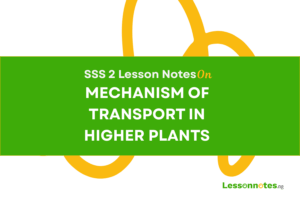Evolution SS3 Biology Lesson Note
Download Lesson NoteTopic: Evolution
SPECIFIC OBJECTIVES: At the end of the lesson, pupils should be able to
- Explain the Darwin’s theory of evolution
- State the Larmarckian’s evolutionary laws
- Discuss the modern theory of evolution
- Identify the evidence of evolution
- Identify forces responsible for evolution.
INSTRUCTIONAL TECHNIQUES:
- Identification,
- explanation,
- questions and answers,
- demonstration,
- videos from the source
INSTRUCTIONAL MATERIALS:
- Videos,
- loudspeaker,
- textbook,
- pictures
NOTE
THEORY OF EVOLUTION
Darwin’s theory of evolution
Charles Darwin’s theory of evolution, presented in his seminal work “On the Origin of Species” (1859), proposes that species evolve through a process of natural selection. His theory of natural selection is as follows:
- Overpopulation: All living organisms should be allowed to produce more offspring that can survive.
- Struggle for existence: Due to overpopulation of offspring, there is a constant competition for existence among offspring
- Offspring shows variation: No two individuals are the same.
- Adaptive characteristics: Some of the offspring are better adapted or fitted to survive the competition than others.
- Inheritance of adaptive characteristics: The well-adapted ones or the fittest will transmit such variation to their offspring, while those with poor adaptation will die off (extinct).
- Development of new species: An accumulation of favourable variation will in a long time lead to a divergence (spread) from the original stock resulting in the formation of new species.
Lamarckian Evolutionary Law
Jean-Baptiste Lamarck proposed a theory of evolution in the early 19th century, His idea of evolution was based on the following theories:
- The theory of need: This theory states that the development of a new part or organ by an organism (plant or animal) results from the need for the part or organ for that particular organism. For instance, the early ancestors of snakes had short bodies and legs. As the land was charging during its formation, many narrow places and dense vegetation were formed, for snakes to walk through narrow places and dense vegetation, they started stretching their bodies to become elongated so that they could easily crawl through the vegetation instead of walking would be preferred.
- The theory of acquired characteristics inheritance: Structures acquired by organisms during their lifetime are transmitted to the next generation by inheritance. The modern giraffe is believed to have evolved from a giraffe with a short neck and short legs. When competition for low grasses among herbivorous animals began, the short-necked and short-legged giraffe started to starch. Their neck-legged giraffe started to stretch their neck and four legs to reach the leaves of the trees.
Also, the load and duck originally had no webs between their toes, but as they visited water frequently for food, their need to develop webs for swimming became necessary.
Modern Evolutionary Theory
Modern evolutionary theory builds upon Darwin’s ideas and incorporates advancements in genetics and other scientific disciplines. Major components include:
- Natural Selection: Charles Darwin’s principle remains central, emphasising the differential survival and reproduction of individuals with traits advantageous to their environment.
- Genetics: The discovery of DNA and the understanding of genetics provide a molecular basis for inheritance. The modern synthesis integrates genetics with natural selection, explaining how traits are passed from one generation to the next.
- Mutation: Genetic mutations are the source of variation in populations. Mutations can lead to new traits, and their occurrence is essential for the evolution of species.
- Gene Flow and Genetic Drift: These mechanisms contribute to the change in gene frequencies within populations. Gene flow involves the exchange of genes between populations, while genetic drift is the random fluctuation of gene frequencies.
- Speciation: The process by which new species arise, often involving reproductive isolation. This can occur through various mechanisms, including geographic separation and adaptive divergence.
- Adaptation: Species evolve traits that enhance their survival and reproduction in specific environments. This process is a result of natural selection acting on beneficial variations.
Evidence of evolution
- Fossil Record: The fossil record is a crucial source of evidence supporting the theory of evolution. The following are essential to support evolution;
i. Transitional Fossils: Fossils of organisms that exhibit characteristics of both ancestral and descendant groups provide evidence for evolutionary transitions. Examples include the Archaeopteryx, showing features of both reptiles and birds.
ii. Stratigraphy: The arrangement of fossils in rock layers (strata) reflects a chronological sequence. This ordering aligns with the predicted evolutionary relationships based on morphological and genetic similarities.
iii. Extinct Species: Fossils of extinct species, such as dinosaurs, demonstrate that the Earth’s biodiversity has changed over time, and many forms of life no longer exist.
2. Embryology: Embryological evidence supports the idea of common ancestry and shared developmental pathways:
i. Similarities in Early Stages: Embryos of different species often exhibit striking similarities during early developmental stages, reflecting shared ancestry. For example, vertebrate embryos often show comparable structures like gill slits and tails.
ii. Vestigial Structures: Some embryonic structures become vestigial in adults, providing a glimpse into evolutionary history. The presence of a tail during early human embryonic development is an example of a vestigial structure.
iii. Hox Genes: Conservation of Hox genes, which control the body plan and development, across diverse organisms, supports the idea of a common ancestry.
Forces responsible for the evolution
The forces responsible for evolution are as follows,
- Mutation: Introduces genetic variation by altering the DNA sequence.
- Gene Flow: Involves the transfer of genes between different populations, promoting genetic diversity.
- Genetic Drift: Random changes in allele frequencies within a population over time, especially in small populations.
EVALUATION:
- State Larmarck’s first law of evolution
- Mention 4 factors responsible for evolution
- Discuss the modern theory of evolution
- Identify the factors that prove evolution
CLASSWORK: As in evaluation
CONCLUSION: The teacher commends the students positively





















